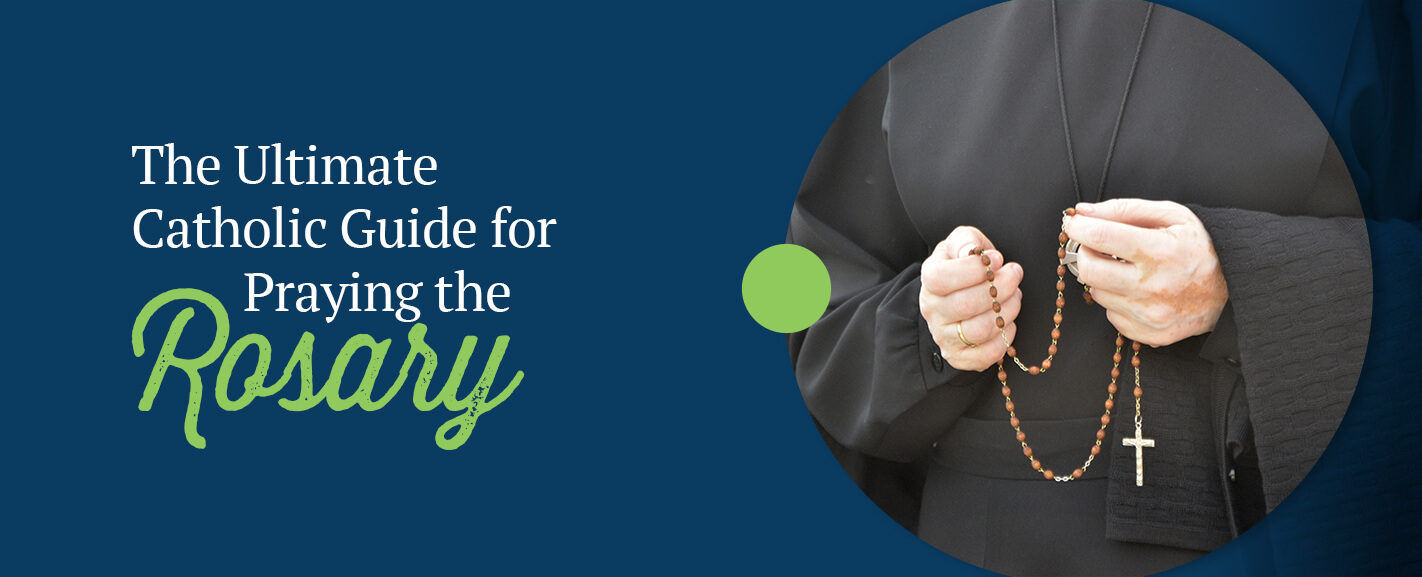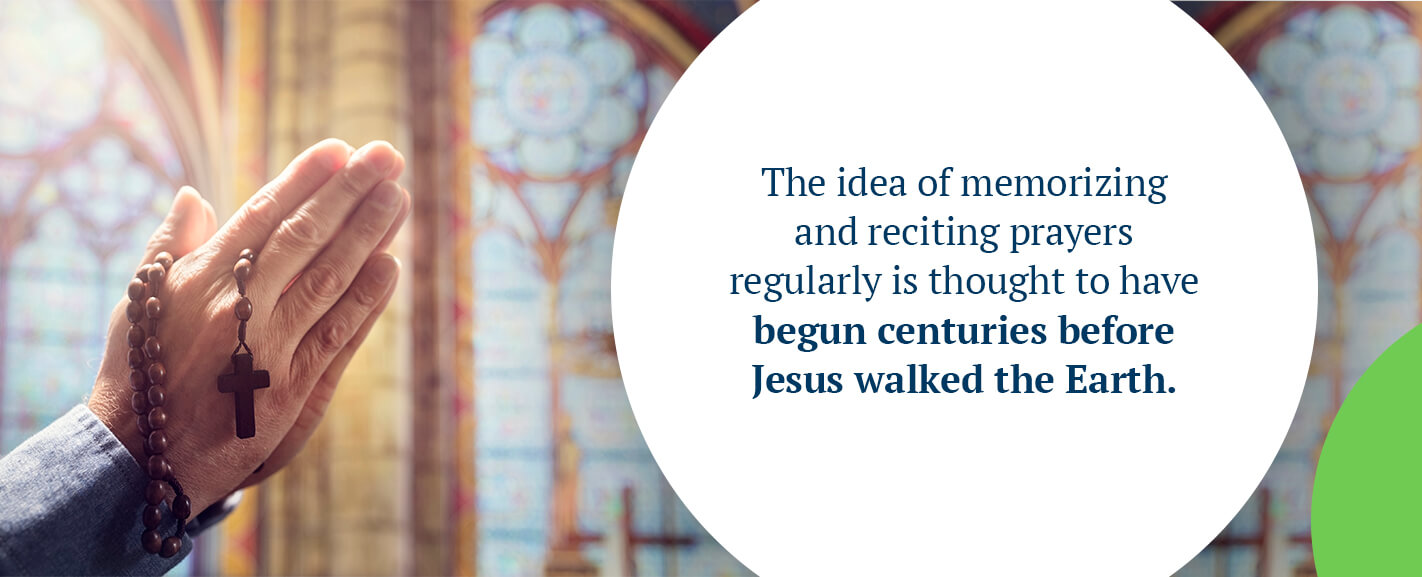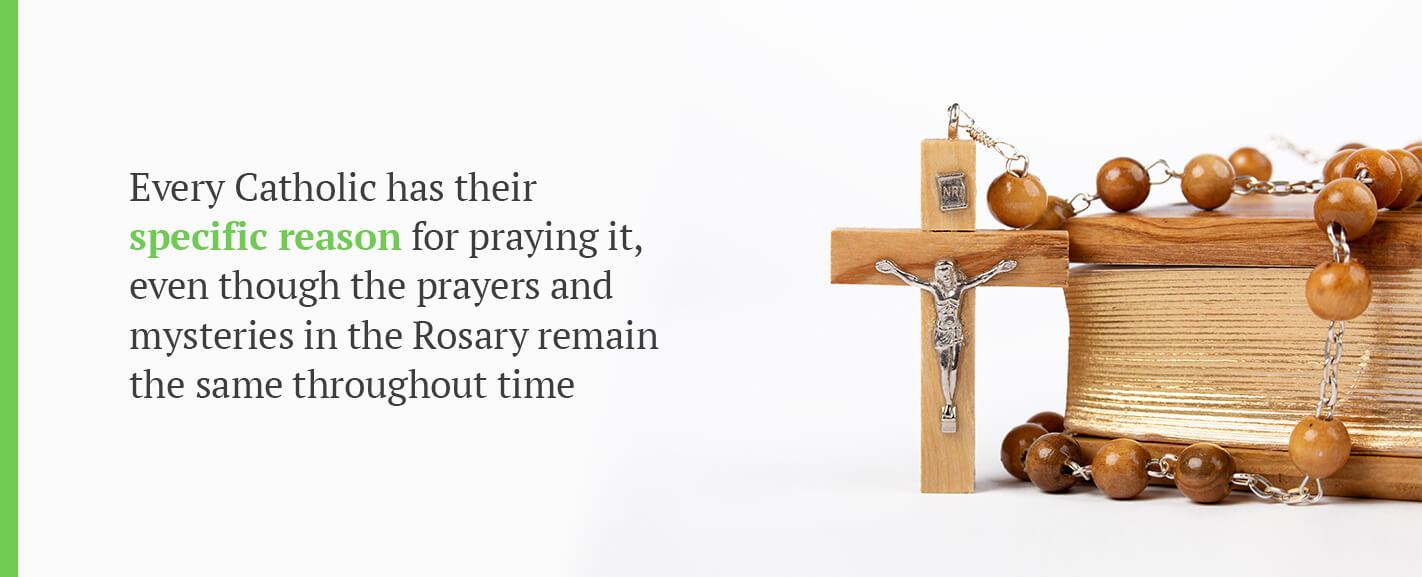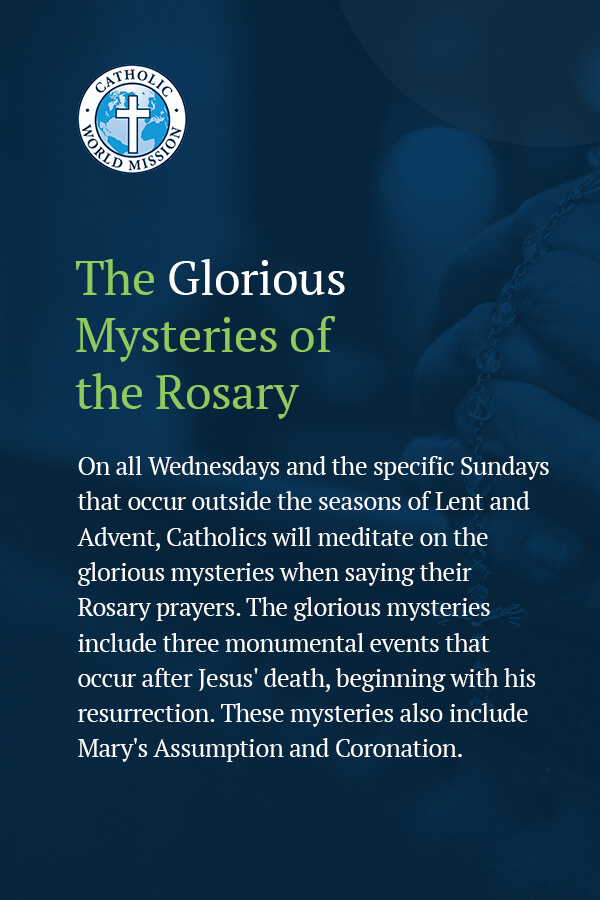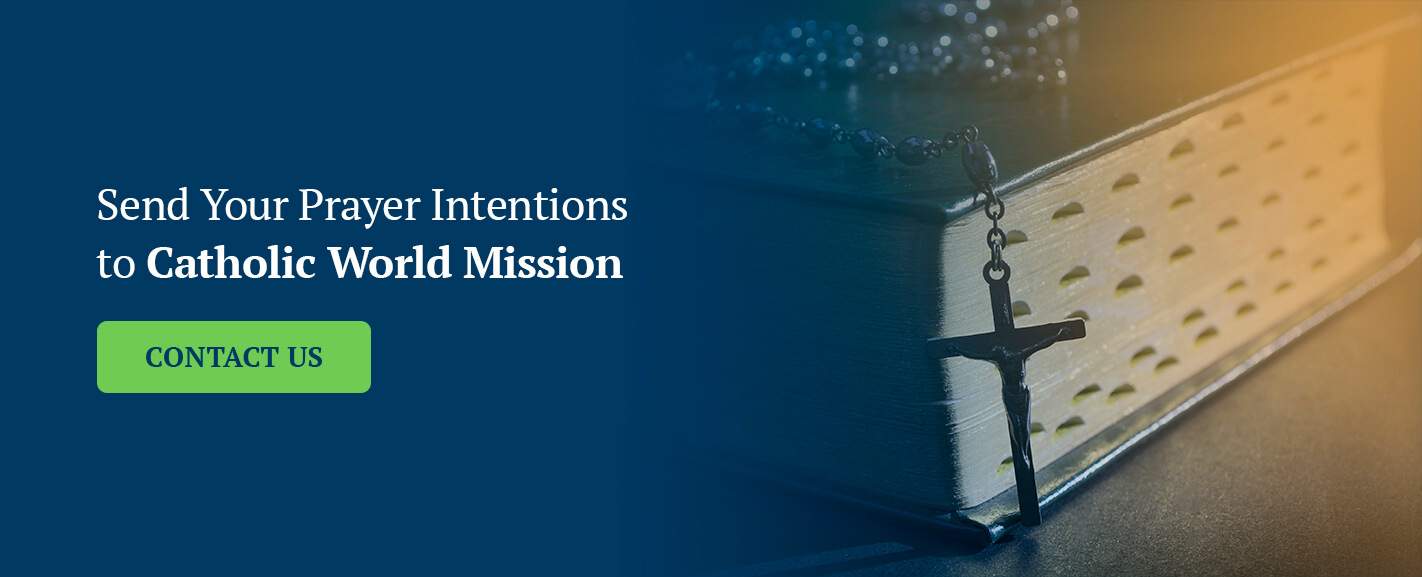The life of a devout Catholic is full of prayer and meditation. It is through prayer that you can make your requests known to God and give Him praise for all He has done for your life. By meditating on the Word of God, you can grow closer to Him, gain a better understanding of His nature and discover what He wants you to focus on in your life.
Catholics memorize prayers to help them on their journey of approaching God in those quiet times of the heart. One item many Catholics use when praying and meditating is the Holy Rosary. Although you may have seen a Rosary before, you may have some questions. Why do people pray the Rosary? And what is the purpose of the Rosary beads? Find the answers to all your Rosary-related questions below.
What Is the Holy Rosary?
When people think of the Rosary, they often visualize the familiar set of beads that Catholics hold in their hands as they pray. But the Holy Rosary is more than just a string of knots and beads. It’s a multi-faceted prayer that guides Catholics into a place of meditation on 20 fundamental mysteries of faith, honoring the Virgin Mary, and following the life of Jesus. Praying the Rosary also serves as a sign of dedication and love for God.
Headline
The Rosary guides Catholics through the many parts of the prayer concentrating on each element that symbolizes the life of Jesus. Here are the parts of the Rosary:
The sign of the cross: The Crucifix at the beginning of the Rosary reminds Catholics that Jesus died to redeem the sins of the world. To begin the Rosary one holds the Crucifix and prays the Apostles’ Creed.
- The chain: The chain holds all the pieces of the Rosary together. But it too, serves more than a utilitarian purpose. Throughout the Rosary, the chain connects all elements and is positioned before each new “decade” (ten beads) where a Glory Be prayer is said before moving on to following bead.
- The small beads: The small beads throughout the Rosary represent Hail Mary prayers, which Catholics recite 53 times. Three Hail Marys after the initial Our Father at the very beginning of the Rosary and ten in each decade; five decades in all.
- The large beads: There are six Our Father beads on the Rosary. Immediately following the Crucifix at the start of the Rosary is the first and the second. Then following each Glory Be and prior to each decade The Our Father is prayed to remind Catholics to meditate on the mysteries of Catholicism.
- The centerpiece medallion: The centerpiece medallion of the Rosary can take slightly different appearances, but its purpose remains the same. This is the final step to a complete Rosary prayer and is the moment at which Catholics pray the Hail, Holy Queen.
You can get a step-by-step process of praying the Rosary and learn more about the specific prayers recited in the Rosary in a later section titled “How to Pray the Rosary.” In the next section, we’ll take a closer look at how the Rosary came to be.
Where Did the Rosary Originate From?
To understand why Catholics use the Rosary and how you can use it in your Catholic practice, it’s important to understand the origin of the Rosary. The idea of memorizing and reciting prayers regularly is thought to have begun centuries before Jesus walked the Earth. People may have used pebbles or rocks to keep count of the prayers they said, so they could know when they reached their recitation goals.
Fast forward to several hundred years after Jesus. During the Middle Ages, devout monks would recite all 150 Psalms every day or week as part of their devotion to God. People living near these monks may have wanted to emulate this devotion, but the printed Bible would have been a rare commodity since the printing press was still several hundred years in the future.
Their solution was to recite Our Fathers using a string with tied knots to keep track. They’d later replace the knots with beads, and the modern concept of the Rosary was born. Over time, it received the name “rosarium,” which means “rose garden” — a common term to describe a collection of similar things. In this case, the similar items were the many prayers bound together and repeated in the Rosary.
St. Dominic and the Rosary
Catholic tradition says St. Dominic de Guzmán implemented the Rosary. St. Dominic lived from 1170 to 1221 and was active in trying to reverse heretical teachings that were spreading during those years. He started his own mendicant order, which became known as the Dominicans. They roamed the countryside preaching and attempting to influence those who had fallen away from the Church, to return.
Although neither St. Dominic nor his followers ever claimed to implement the Rosary, Blessed Alan de la Roche claimed to have a dream in the 15th century that solidified this tradition. He claimed to have a dream showing Mary giving St. Dominic the Rosary, telling him to use it in his efforts to subvert the heresy that was spreading in his day.
Many prominent Catholic leaders, including Pope Benedict XIV, Leo X, St. Pius V, Sixtus V, Gregory XIII and many others, have given credence to this dream. Their claims have cemented St. Dominic as the founder of the Rosary as Catholics know it today according to Catholic tradition. There is evidence of a vision St. Dominic received from Our Lady, but nothing explicit that connects it to the invention of the Rosary.
Interestingly, there is another St. Dominic who is often mentioned in connection with the development of the Rosary as we know it today.
This St. Dominic, according to the Catholic Encyclopedia, was a “Carthusian monk and ascetical writer, born in Poland, 1382.” There is substantial evidence that he added to existing devotions that involved the counting of prayers and created meditations on the life of Christ.
When Do Catholics Pray the Rosary?
The Catholic figures above, and many more throughout history, have advocated for praying the Rosary. Thus, Catholics can approach praying the Rosary at the times that suit them best. For some people, praying a single decade of the Rosary — every step of the Rosary through the first 10 Hail Marys and the first mystery — is sufficient for their schedule. But if you have more time to spare, you can go through all five decades of prayers and mysteries, completing the entire Rosary.
Catholics will pray the Rosary during their daily devotions or as part of a more strict religious practice. Others will recite the Rosary during difficult times of life when they need divine intervention. Every Catholic has their specific reason for praying it, even though the prayers and mysteries in the Rosary remain the same throughout time.
How to Pray the Rosary
So, how does a Rosary work? You may be wondering where and how you should begin. You may also be curious about the many prayers represented by the Rosary’s parts. Below, you can find each step of the Rosary with helpful information to get you started.
1. Make the Sign of the Cross and Pray the Apostle’s Creed
Start by making the sign of the cross on the crucifix. Then pray the Apostle’s Creed. This prayer describes core beliefs of the faith, including the nature and relationship of God, Jesus and the Holy Spirit. It goes on to refer to Jesus’ life, death and resurrection. Finally, the Apostle’s Creed speaks of the communion of the Catholic Church as we await Jesus’ eventual return.
2. Pray the Our Father
Move onto the first single bead on the Rosary and pray the Our Father. You may know the Our Father by other names, including the Lord’s Prayer, which you can find in Matthew 6:9-13. This prayer emphasizes the holiness of God and asks Him for his everyday provision and forgiveness. Perhaps most importantly, the Our Father asks God to protect you from the temptations of the evil one, Satan.
3. Pray Three Hail Marys
Pray three Hail Marys, one for each of the small beads that follow the Crucifix and Our Father at the beginning of the Rosary. This prayer focuses on Mary, the Mother of Jesus. The words bestow blessings on Mary, setting her apart from all other women as the one who birthed and raised Jesus. In the last few lines of the prayer, she is asked to pray for humanity both now and at the time of one’s death.
4. Pray the Glory Be
Move on to the visible section of the chain after the three small beads. Here, you’ll pray the Glory Be. This prayer gives glory to the Father, the Son and the Holy Spirit and emphasizes the everlasting nature of the Trinity.
5. Begin the First Decade on the First Single Bead
At this point in the Rosary prayer, you can begin the first decade on the next single bead. The Rosary contains five decades, each beginning on their corresponding large bead. Ten small beads representing Hail Mary prayers separate each of the large beads that mark the start of the decade.
When you get to the first single bead, start the decade by praying the Our Father and meditating on the first mystery. The mystery changes depending on the day of the week, and there are four types of mysteries on which you will meditate.
The Joyful Mysteries of the Rosary
Catholics will pray The Joyful Mysteries on Mondays and Saturdays. These mysteries will also be prayed on Sundays during the Advent season. Each of the joyful mysteries is a meditation on an aspect of Jesus’ incarnation, which are the events surrounding and leading up to his birth.
The Sorrowful Mysteries of the Rosary
The Sorrowful Mysteries are the focus of meditation on Tuesdays and Fridays, but Catholics will also pray them on Sundays during the season of Lent. These mysteries dwell on the passion of Jesus, which include the events leading up to his crucifixion and the moment of his death.
The Glorious Mysteries of the Rosary
On all Wednesdays and the specific Sundays that occur outside the seasons of Lent and Advent, Catholics will meditate on the glorious mysteries when saying their Rosary prayers. The Glorious Mysteries include three monumental events that occur after Jesus’ death, beginning with his resurrection. These mysteries also include Mary’s Assumption and Coronation.
The Luminous Mysteries of the Rosary
For many years, only the joyful, sorrowful and glorious mysteries were a part of the Rosary. That was until Pope St. John Paul II added the Mysteries of Light in 2002. The luminous mysteries focus on five of the most important events from Jesus’ life on Earth.
If you’re curious about the specific mysteries included in the Rosary, keep reading.The Luminous Mystery descriptions are included with corresponding days in the decades below. Here are the mysteries of the first decade of the Rosary that you’ll meditate on after praying the Our Father on the single bead that begins the decade:
- Mondays and Saturdays — the Joyful Mystery of The Annunciation: You can find the passage for the Annunciation in Luke 1:26-27. These verses describe when God sent the angel Gabriel to Nazareth to visit Mary and tell her that God had chosen her to give birth to Jesus, His son. The passage reveals Mary’s humble and faithful responses, which serve as an example of humility to Catholics.
- Tuesdays and Fridays — the Sorrowful Mystery of The Agony of Jesus in the Garden: You can read about this sorrowful mystery in Matthew 26:36-39. Here, Jesus goes to the Garden of Gethsemane to pray to God the Father. Although Jesus agonized over what was about to happen — His crucifixion — He still prayed that God’s will would be done over His. Catholics should also pray to follow God’s will above their own.
- Wednesdays and Sundays — the Glorious Mystery of the Resurrection: The Resurrection is the first of The Glorious Mysteries, and you can find its passage in Luke 24:1-5. This mystery is indeed glorious and fundamental to the Catholic faith. Here, Jesus overcomes death, rising again on the third day just as He promised. This mystery reminds Catholics to have faith in God’s promises.
- Thursdays — the Luminous Mystery of The Baptism in the River Jordan:
Jesus’Jesus’ baptism marked the start of His earthly ministry. You can find it in Matthew 3:16-17. One of the most important aspects of this mystery is that God’s spirit descended on Jesus the moment He came up from the water. God’s own voice stated Jesus was His Son, and He was well-pleased with Him.
After meditating on the day’s first mystery, pray the 10 Hail Marys that correspond with the following ten consecutive beads. Then pray a Glory Be on the chain before the next single bead.
6. Begin the Second Decade on the Second Single Bead
Touch the next single bead on the Rosary necklace and pray the Our Father to begin the second decade. Here are the mysteries that you’ll meditate on, depending on the day of the week:
- Mondays and Saturdays — the Joyful Mystery of The Visitation: The Visitation, found in Luke 1:39-42, recounts Mary visiting her cousin Elizabeth after receiving the angel Gabriel’s news. Upon hearing Mary’s greeting to Elizabeth, Elizabeth’s child leaped in her womb. Elizabeth then stated that Mary was most blessed among women and blessed Jesus, who was in her womb.
- Tuesdays and Fridays — the Sorrowful Mystery of The Scourging at the Pillar: Matthew 27:26 describes Jesus’s scourging after being sentenced to death by crucifixion. This was the first of His violent abuse at the hands of His accusers. You can meditate on Jesus’ mortification here.
- Wednesdays and Sundays — The Glorious Mystery of The Ascension: Mark 16:19 recounts Jesus’ ascension into heaven, where He sat at God’s right hand. Ponder the great hope you have in Jesus as you meditate on this mystery.
- Thursdays — the Luminous Mystery of The Wedding Feast at Cana: Found in John 2:1-11, The
- Feast at Cana marked the first of Jesus’ miracles when He turned water into wine. Mary showed her faith in Jesus by telling the wedding helpers to do all that Jesus would tell them to do.
Meditate on the appropriate mystery for the day and then pray 10 Hail Marys, one for each of the following small beads. Then pray the Glory Be while touching the chain before the next large bead.
7. Begin the Third Decade on the Third Single Bead
Begin the third decade by touching the next bead and praying the Our Father. Then begin meditating on the day’s mystery:
- Mondays and Saturdays — the Joyful Mystery of The Nativity: Luke 2:1-20 contains the well-known passage of the Nativity, Jesus’ birth. Meditate on the fact that Jesus left His position in heaven to be born in a lowly manger and live out a hard life on Earth, all for God’s love of humankind.
- Tuesdays and Fridays — the Sorrowful Mystery of The Crowning with Thorns: In Matthew 27:27-29, Jesus’ humiliation and torture continue when His persecutors stripped Him of His clothes and placed a painful crown of thorns upon His head. Meditate on Jesus’ courage as He continued submitting to God’s ultimate plan.
- Wednesdays and Sundays — the Glorious Mystery of The Descent of the Holy Spirit: After Jesus’ ascension, He fulfilled His promise of sending his disciples the Holy Spirit in Acts 2:1-4. When you meditate on this, pray that God would fill you with the wisdom of the Holy Spirit in your own life.
- Thursdays — the Luminous Mystery of Jesus’ Proclamation of the Coming of the Kingdom of God: In Mark 1:15, Jesus proclaimed that God’s kingdom was at hand and that all should repent of their sins. Meditate on your conversion from your old way of life into the new life God has given you as a follower of Jesus.
Upon finishing your day’s meditation, pray the ten Hail Marys on the ten beads and the Glory Be on the exposed chain before the next large bead.
8. Begin the Fourth Decade on the Fourth Single Bead
Touch the next bead that marks the start of the fourth decade. Pray the Our Father, and begin meditating on the mystery of the day:
- Mondays and Saturdays — the Joyful Mystery of The Presentation: The moment when Mary and Joseph presented Jesus in the temple is in Luke 2:21-24. Joseph and Mary were following the law of Moses, displaying their obedience to God.
- Tuesdays and Fridays — the Sorrowful Mystery of The Carrying of the Cross: In Mark 15:21-22, you can read the record of Simon the Cyrenian carrying the cross of Jesus for Him as they made their way to Golgotha, where Jesus was to be crucified. Simon displayed patience and obedience, going out of His own way to help Jesus.
- Wednesdays and Sundays — the Glorious Mystery of the Assumption of Mary: Luke 1:48-49 is Mary’s statement that people throughout the ages will refer to her as blessed because God had done mighty things through her. Catholics meditate on their devotion to Mary during this time.
- Thursdays — the Luminous Mystery of The Transfiguration: The account of Jesus’ Transfiguration in Matthew 17:1-2 describes the moment when Peter, James and John witnessed Jesus’ countenance change to one as bright as the sun, displaying His divine glory. This can serve as a meditative reminder to seek holiness in your life.
As with the other decades, you’ll move on to praying the ten Hail Marys on their beads, followed by the Glory Be on the chain after those beads.
9. Begin the Fifth Decade on the Fifth Single Bead
Move on to the next single bead and pray the Our Father to begin the fifth and final decade. Here are the mysteries for this decade:
- Mondays and Saturdays — the Joyful Mystery of The Finding of Jesus in the Temple: In Luke 2:41-47, you can read the story of Jesus as a young boy staying behind in Jerusalem to engage in spiritual discourse in the temple and Mary and Joseph’s reaction to finding Him there.
- Tuesdays and Fridays — the Sorrowful Mystery of The Crucifixion: The moment of Jesus’ crucifixion and death found in Luke 23:33-46 is perhaps the most sorrowful mystery of all, as Jesus gave Himself up for the sins of the world. Many Catholics use this time to meditate on their sorrow for their sins.
- Wednesdays and Sundays — the Glorious Mystery of The Coronation of Mary: Revelation 12:1 describes a vision of the Apostle John of a woman, Mary, receiving celestial recognition, which Catholics use to meditate on the grace of a happy death.
- Thursdays — the Luminous Mystery of The Institution of the Holy Eucharist: Jesus implemented the Holy Eucharist in Matthew 26:26, which is an Institution of the Catholic Church to this day. You can meditate on this lasting Institution and its representation of Christ’s broken body and spilled blood.
Pray the last ten Hail and a final Glory Be before moving on to the final step of the Rosary.
10. End the Rosary by Praying the Hail Holy Queen
To complete the Holy Rosary, move to the centerpiece medallion and pray the Hail Holy Queen. This prayer praises Mary and lays our human struggles at her feet. It beseeches Mary to pray to God on our behalf that we would be worthy of Jesus’ promises to us. It closes with a meditation on imitating the mysteries of the Rosary.
Send Your Prayer Intentions to Catholic World Mission
Praying the entire Rosary can be a lot to remember, but the Rosary helps Catholics around the world count their prayers and ensure a complete time of prayerful meditation. The Rosary helps people draw closer to God, which is our goal for communities all over the world here at Catholic World Mission.
We strive to give people hope that they can leave their old lives of poverty behind and step into an empowered future. We emphasize education so people can help themselves for years to come, changing the trajectory of their communities. And we do all this while sharing the love of God with everyone we meet.
We invite you to donate to our cause today. You can also send us your prayer intentions, and we will lift up your requests on your behalf.

